#Berlin Giulietta
Explore tagged Tumblr posts
Text

Berlin Giulietta | Alfa Romeo
25 notes
·
View notes
Text
'Central Station': a Journey of Hope and Self-Discovery
By JANET MASLIN
In Walter Salles' "Central Station," a hit at Sundance and the winner of top honors at this year's Berlin Film Festival, a cynical, joyless woman crosses paths with a lonely young boy. There's plenty of room for sentimentality here, but the wonder of Salles' film is all in the telling.
Beautifully observed and featuring a bravura performance by the Brazilian actress Fernanda Montenegro, it gracefully watches these oddly paired characters develop a fractious bond that winds up profoundly changing both of them. Salles' background as a documentary filmmaker also gives this lovely, stirring film a strong sense of Brazil's impoverished rural landscape once its principals take to the road.
Vinicius de Oliveira was a 10-year-old shoeshine boy when he encountered Salles at an airport and asked the man to help him buy a sandwich. Now he movingly plays the child named Josue who is foisted by fate onto this irascible older woman. Ms. Montenegro's Dora is a former schoolteacher who earns her living writing letters for the illiterate at the Rio de Janeiro railroad station of the title.
She spends all day listening to the heartfelt thoughts of strangers, writes them down and then makes cruel fun of them when she gets home. After joking about the letters with her kinder friend Irene (Marilia Pera of "Pixote"), Dora never bothers to mail them. Then a letter by Josue's mother permanently alters Dora's world.
With suspicious little Josué in tow, the mother dictates a beseeching letter to her absent husband, then leaves the station and is killed by a bus. Suddenly, the boy knows no one and has no place to go.
Despite her hardened bitterness and obvious loathing for children, Dora grudgingly takes him home, where Irene finds Josue adorable and is happy to help him. But Dora has other plans; she wants to sell Josue to an adoption racket and effectively trade him in for a new television set.
This scheme subsequently gets Dora into so much trouble that she abruptly decides to leave town. And she agrees to take Josue on a wild goose chase in search of his father, whom the boy says is a carpenter named Jesus. These are the events that send "Central Station" off into the countryside, and take both these hard-bitten travelers into parts unknown.
Salles brings great tenderness and surprise to the events that punctuate this odyssey, from the boy's drunken outburst on a bus to Dora's shy flirtation with a trucker she meets along the way. By the time the travelers are caught up in a religious pilgrimage, the film has taken on a Felliniesque sense of spiritual discovery just as surely as Ms. Montenegro resembles Giulietta Masina in both feistiness and appearance.
Her performance here is superbly modulated as Dora begins rediscovering herself in ways she could never have expected. Though eternally gruff, she finds herself regaining a long-lost faith in life and in the very humanity she scorned when those letter writers came her way.
The film eventually views these strangers' faces in the rapt, joyous spirit that is the story's greatest reward and that becomes Dora's saving grace. And it is the filmmaker's elegant restraint that makes such sentiments so deeply felt.
Salles directs simply and watchfully, with an eye that seems to penetrate all the characters who are encountered on Dora's and Josue's journey. His film is also scored with a gentle piano melody that heightens its heartfelt embrace of the world that "Central Station" sees.
"Central Station" is rated R (Under 17 requires accompanying parent or adult guardian). It includes brief, sudden violence and mild profanity.
CENTRAL STATION
Directed by Walter Salles; written (in Portuguese, with English subtitles) by Joao Emanuel Carneiro and Marcos Bernstein, based on an original idea by Salles; director of photography, Walter Carvalho; edited by Isabelle Rathery and Felipe Lacerda; music by Antonio Pinto and Jaques Morelembaum; production designers, Cassio Amarante and Carla Caffe; produced by Arthur Cohn and Martine de Clermont-Tonnerre; released by Sony Pictures Classics. Running time: 115 minutes. This film is rated R. WITH: Fernanda Montenegro (Dora), Marilia Pera (Irene), Vinicius de Oliveira (Josue), Soia Lira (Ana) and Othon Bastos (Cesar).
#Central Station#Central do Brasil#Walter Salles#Joao Emanuel Carneiro#Marcos Bernstein#Walter Carvalho#Isabelle Rathery#Felipe Lacerda#Antonio Pinto#Jaques Morelembaum#Cassio Amarante#Carla Caffe#Arthur Cohn#Martine de Clermont-Tonnerre#Sony Pictures Classics#Fernanda Montenegro#Marilia Pera#Vinicius de Oliveira#Soia Lira#Othon Bastos.
0 notes
Text
THE MOMENT is a temporary experience in the time-space continuum. A hermaphroditic nomadic exhibition and space. It was initiated in Frankfurt am Main, moved to Mexico City and is currently based in Berlin Mitte, Ackerstraße.
Instagram @ themoment.space
instagram
NEXT OPENING ´Amnesia of Balance´ 11.09.2024 16:00-21:00h, Ackerstr. 173, 10115 Berlin Mitte
Berlin Art Week opening times 12-15 September. 11-20h

instagram
THE MOMENT | Berlin Art Week

Dan Bodan, Olga Cerkasova, Inga Danysz, Merike Estna, Isabella Fürnkäs, Nschotschi Haslinger, Raphael Hefti, Giulietta Ockenfuß, Niclas Riepshoff, Maximilian Thiel, Lola von der Gracht, Helga Wretman
Previous exhibitions:
Therapy Room (kubaparis.com)
THE MOMENT — A series of art events at Mexico City – OFLUXO
Echosystem in The Moment / Mexico City – Daily Lazy (daily-lazy.com)
instagram
2024 RECORDS OF AN UNSTEADY LIFE (Berlin):
Olga Cerkasova
Catherina Cramer & Giulietta Ockenfuß
Isabella Fürnkäs
Zoë Claire Miller
2023 THERAPY ROOM (Berlin)
Leda Bourgogne
Olga Cerkasova
Victoria Colmegna
Zuzanna Czebatul
Tomás Díaz Cedeño
Isabella Fürnkäs
Nschotschi Haslinger
Theresa Patzschke
Sóley Ragnarsdóttir
Eric Sidner
2021 ECHOSYSTEM (Mexico City)
Gwladys Alonzo
Hasanlu Armastajad (Merike Estna & Jaime Lobato)
Asma
José Eduardo Barajas
Tomás Díaz Cedeño
Olga Cerkasova
Paola De Anda
Adriana Lara
Mauricio Guillén
Diego Salvador Rios
Emilio Gómez Ruiz
0 notes
Note
what do you think about komische oper berlin 2015 tales of hoffman
oh I have....Thoughts on this one
TL;DR I hated it. if you liked the production you probably don't want to read this. I'm not very nice about it lol
I know people love Kosky but I won't forgive him for this. idk if I've seen anything else of his.
I watched the archival video stream however long ago that was and I was quite excited because the production looked interested and it professed to be the Kaye edit, which is the most recent critical edit and rarely produced. HOWEVER, it most definitely was not the Kaye edit. instead...
-large chunks of recits were missing -some dialogue was changed -scenes were cut or missing -long spoken monologues were inserted between acts (I presume they were excerpts from the real Hoffmann's work that inspired the opera, which is interesting, but it really didn't work).
Additionally, some lines were switched around or given to other characters. For example, Andres was taken out and replaced by one of the Hoffmanns.
And I say "one of" BECAUSE
they director had three different actors portraying Hoffmann.
I read a note saying he was playing off the tradition of having multiple performers playing the heroines, or even way back when the Villains were sometimes played by different performers.
in my humble opinion, that's just dumb.
there are REASONS that the heroines are played by separate performers. yes, it tends to be better when they're all played by the same diva, and we see that more and more lately, but I do no at all blame performers who choose to just sing one of the ladies because the singing style for each is pretty different. it makes much less sense for the villains to be played by different performers, and as such this is hardly ever seen anymore. Out of the almost 50 filmed productions I've seen, I've only seen that happen once.
so why have different actors play Hoffmann?
aside from "it's kind of funny" literally what is the point? The only thing that makes it vaguely interesting is that one of them is a baritone (in the Giulietta act iirc, it's been a while) and that's interesting because the role was initially going to be written for a baritone but that idea was scrapped because come on, how can a character like Hoffmann not be a tenor.
none of the Hoffmanns look or act the same so there's a deliberate attempt at discontinuity here. idk if they're trying to go for some breaking up of his psyche or id/ego whatever, but it doesn't work. the point of this opera is that the same guy (Hoffmann) goes through all these wacky scenarios with different people who also actually turn out to be the same people. making Hoffmann be different people throughout takes away from this and adds nothing.
also, the Hoffmann/Nicklausse dynamic (which as you all probably know by now is my favorite part of the opera) is not good. they push each other around and at one point Hoffmann grabs Nicklausse by the arm and twists it until he falls over. this is like their first interaction in the production so it doesn't set the mood very well. they do get to dance in the Olympia act and Nicklausse gets to be all protective of him in the Giulietta act, and they do have the Violin Aria but it's in the wrong place and he sings it to the speaking Hoffmann from the Prologue and interludes so it's really disconnected from the rest of the story.
the rest of the production is just weird. Nicole Chevalier plays all the divas and she deserves so much better. Her Antonia and Giulietta were okay but Olympia (and that act overall) were just weird. she was in a box. two of the Hoffmanns kept rotating during the trio des yeux.
the stage and set were interesting--diamond-shaped platform, glass bottles everywhere--but it couldn't save the rest. the only act I enjoyed even a little was the Giulietta one. standing on its own I could see it being okay. Chevalier was a great Giulietta and the Hoffmann in that act was pretty okay, and the set and darkness and creepy chorus members worked to make a pretty decent act.
but then it's ruined because there's no real epilogue, no grand reveal of what the stories all are, and no closing monologue for the Muse followed by the typical jaw-dropping chorus. Instead, we get the speaking Hoffmann lying in a coffin. Nicklausse sits on the coffin and together they sing "la ci darem la mano" as the lights slowly go down.
EXCUSE ME, WHAT?
the director references Don Giovanni a lot in this. yeah, yeah, I know Stella is performing that opera but I'm tired of directors trying to make some grand connections. I really don't think there are any. I think Don Giovanni was just popular. I can't remember all the ways the production referenced Don G and I think honestly I've blocked some of it out but I remember being super annoyed with it because it just. didn't. work.
I liked Nicklausse's outfit. stylish and kinda sparkly. he was so gay but had nothing to work with.
anyway there are my thoughts, hope you enjoyed lol
1 note
·
View note
Photo

Sandra Milo in Giulietta Degli Spiriti (1965)
Swiss-German-British postcard by News Productions, Baulmes / Filmwelt Berlin, Bakede / News Productions, Stroud, no. 56522. Photo: Collection Cinémathèque Suisse, Lausanne. Sandra Milo in Giulietta Degli Spiriti/Juliet of the Spirits (Federico Fellini, 1965) produced by Rizzoli.
718 notes
·
View notes
Photo
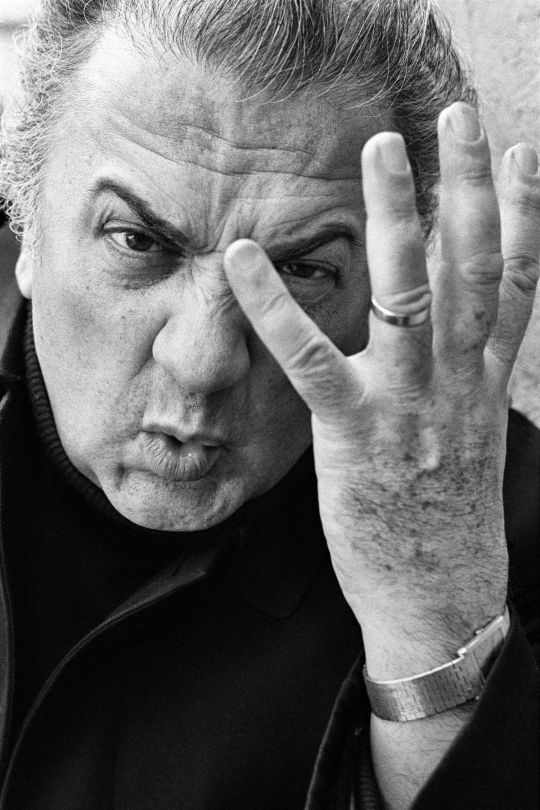
Federico Fellini, Cavaliere di Gran Croce OMRI, was born on January 20, 1920 in Rimini, then a small town on the Adriatic Sea. He was an Italian film director and screenwriter known for his distinctive style, which blends fantasy and baroque images with earthiness. He is recognized as one of the greatest and most influential filmmakers of all time. His films have ranked highly in critical polls such as that of Cahiers du cinéma and Sight & Sound, which lists his 1963 film 8 1⁄2 as the 10th-greatest film.
For La Dolce Vita Fellini won the Palme d'Or, was nominated for twelve Academy Awards, and won four in the category of Best Foreign Language Film, the most for any director in the history of the Academy. He received an honorary award for Lifetime Achievement at the 65th Academy Awards in Los Angeles. His other well-known films include La Strada (1954), Nights of Cabiria (1957), Juliet of the Spirits (1967), the "Toby Dammit" segment of Spirits of the Dead (1968), Fellini Satyricon (1969), Roma (1972), Amarcord (1973), and Fellini's Casanova (1976).
Personal and highly idiosyncratic visions of society, Fellini's films are a unique combination of memory, dreams, fantasy and desire. The adjectives "Fellinian" and "Felliniesque" are "synonymous with any kind of extravagant, fanciful, even baroque image in the cinema and in art in general". La Dolce Vita contributed the term paparazzi to the English language, derived from Paparazzo, the photographer friend of journalist Marcello Rubini (Marcello Mastroianni).
Contemporary filmmakers such as Tim Burton, Terry Gilliam, Emir Kusturica, and David Lynch have cited Fellini's influence on their work.
Polish director Wojciech Has, whose two best-received films, The Saragossa Manuscript (1965) and The Hour-Glass Sanatorium (1973), are examples of modernist fantasies, has been compared to Fellini for the sheer "luxuriance of his images".
I Vitelloni inspired European directors Juan Antonio Bardem, Marco Ferreri, and Lina Wertmüller and influenced Martin Scorsese's Mean Streets (1973), George Lucas's American Graffiti (1974), Joel Schumacher's St. Elmo's Fire (1985), and Barry Levinson's Diner (1982), among many others. When the American magazine Cinema asked Stanley Kubrick in 1963 to name his ten favorite films, he ranked I Vitelloni number one.
Nights of Cabiria was adapted as the Broadway musical Sweet Charity and the movie Sweet Charity (1969) by Bob Fosse starring Shirley MacLaine. City of Women was adapted for the Berlin stage by Frank Castorf in 1992.
8 1⁄2 inspired, among others, Mickey One (Arthur Penn, 1965), Alex in Wonderland (Paul Mazursky, 1970), Beware of a Holy Whore (Rainer Werner Fassbinder, 1971), Day for Night (François Truffaut, 1973), All That Jazz (Bob Fosse, 1979), Stardust Memories (Woody Allen, 1980), Sogni d'oro (Nanni Moretti, 1981), Parad Planet (Vadim Abdrashitov, 1984), La Pelicula del rey (Carlos Sorin, 1986), Living in Oblivion (Tom DiCillo, 1995), 8 1⁄2 Women (Peter Greenaway, 1999), Falling Down (Joel Schumacher, 1993), and the Broadway musical Nine (Maury Yeston and Arthur Kopit, 1982). Yo-Yo Boing! (1998), a Spanish novel by Puerto Rican writer Giannina Braschi, features a dream sequence with Fellini inspired by 8 1⁄2.
Fellini's work is referenced on the albums Fellini Days (2001) by Fish, Another Side of Bob Dylan (1964) by Bob Dylan with Motorpsycho Nitemare, Funplex (2008) by the B-52's with the song Juliet of the Spirits, and in the opening traffic jam of the music video Everybody Hurts by R.E.M. American singer Lana Del Rey has cited Fellini as an influence. His work influenced the American TV shows Northern Exposure and Third Rock from the Sun. Wes Anderson's short film Castello Cavalcanti (2013) is in many places a direct homage to Fellini.
Various film-related material and personal papers of Fellini are in the Wesleyan University Cinema Archives, to which scholars and media experts have full access. In October 2009, the Jeu de Paume in Paris opened an exhibit devoted to Fellini that included ephemera, television interviews, behind-the-scenes photographs, Book of Dreams (based on 30 years of the director's illustrated dreams and notes), along with excerpts from La dolce vita and 8 1⁄2.
In 2015, the Blue Devils Drum and Bugle Corps of Concord, California, performed "Felliniesque", a show themed around Fellini's work, with which they won a record 16th Drum Corps International World Class championship with a record score of 99.650. That same year, the weekly entertainment-trade magazine Variety announced that French director Sylvain Chomet was moving forward with The Thousand Miles, a project based on various Fellini works and first developed with Demian Gregory and Tommaso Rossellini, including his unpublished drawings and writings.
Filmography
As a director
1950 Variety Lights co-credited with Alberto Lattuada
1952 The White Sheik
1953 I vitelloni
1953 Love in the City Segment: Un'agenzia matrimoniale
1954 La strada
1955 Il bidone
1957 Nights of Cabiria
1960 La Dolce Vita
1962 Boccaccio '70 Segment: Le tentazioni del Dottor Antonio
1963 8 1⁄2
1965 Juliet of the Spirits
1968 Spirits of the Dead Segment: Toby Dammit
1969 Fellini: A Director's Notebook
1969 Fellini Satyricon
1970 I Clowns
1972 Roma
1973 Amarcord
1976 Fellini's Casanova
1978 Orchestra Rehearsal
1980 City of Women
1983 And the Ship Sails On
1986 Ginger and Fred
1987 Intervista
1990 The Voice of the Moon
As a screenwriter
1942 Knights of the Desert
1942 Before the Postman
1943 The Peddler and the Lady
1943 L'ultima carrozzella Co-scriptwriter
1945 Tutta la città canta Co-screenwriter and story author
1945 Rome, Open City Co-scriptwriter
1946 Paisà Co-scriptwriter
1947 Il delitto di Giovanni Episcopo Co-scriptwriter
1948 Senza pietà Co-scriptwriter
1948 Il miracolo Co-scriptwriter
1949 Il mulino del Po Co-scriptwriter
1950 Francesco, giullare di Dio Co-scriptwriter
1950 Il Cammino della speranza Co-scriptwriter
1951 La città si difende Co-scriptwriter
1951 Persiane chiuse Co-scriptwriter
1952 Il brigante di Tacca del Lupo Co-scriptwriter
1958 Fortunella Co-scriptwriter
1979 Lovers and Liars Fellini not credited
Television commercials
TV commercial for Campari Soda (1984)
TV commercial for Barilla pasta (1984)
Three TV commercials for Banca di Roma (1992)
Documentaries on Fellini
Ciao Federico (1969). Dir. Gideon Bachmann. (60')
Federico Fellini - un autoritratto ritrovato (2000). Dir. Paquito Del Bosco. (RAI TV, 68')
Fellini: I'm a Born Liar (2002). Dir. Damian Pettigrew. Feature documentary. (Arte, Eurimages, Scottish Screen, 102')
How Strange to Be Named Federico (2013). Dir. Ettore Scola.
Fellini died in Rome on 31 October 1993 at the age of 73 after a heart attack he suffered a few weeks earlier, a day after his 50th wedding anniversary. The memorial service, in Studio 5 at Cinecittà, was attended by an estimated 70,000 people. At Giulietta Masina's request, trumpeter Mauro Maur played Nino Rota's "Improvviso dell'Angelo" during the ceremony.
Five months later, on 23 March 1994, Masina died of lung cancer. Fellini, Masina and their son, Pierfederico, are buried in a bronze sepulchre sculpted by Arnaldo Pomodoro. Designed as a ship's prow, the tomb is at the main entrance to the Cemetery of Rimini. The Federico Fellini Airport in Rimini is named in his honour.
Daily inspiration. Discover more photos at http://justforbooks.tumblr.com
37 notes
·
View notes
Text
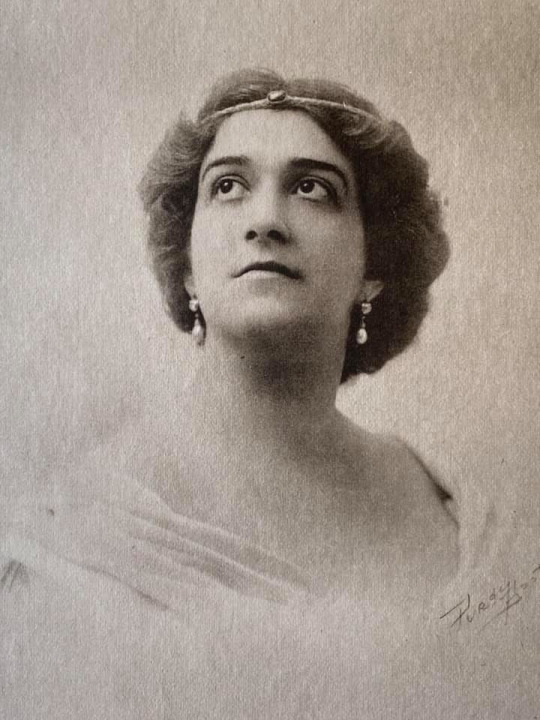
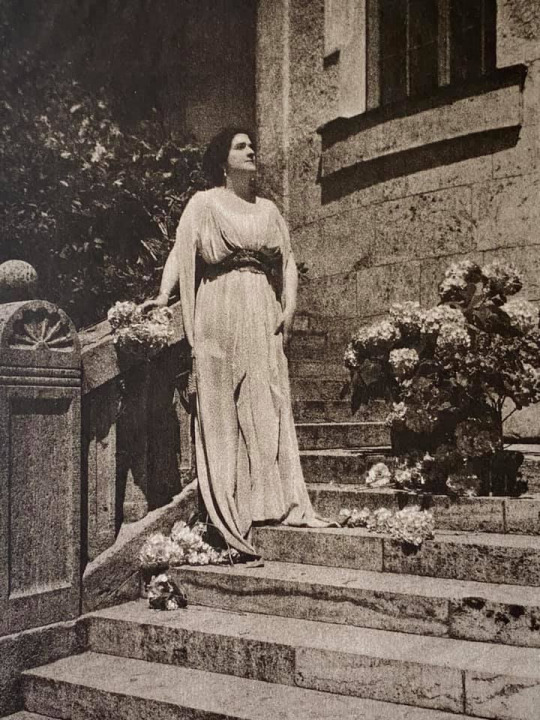
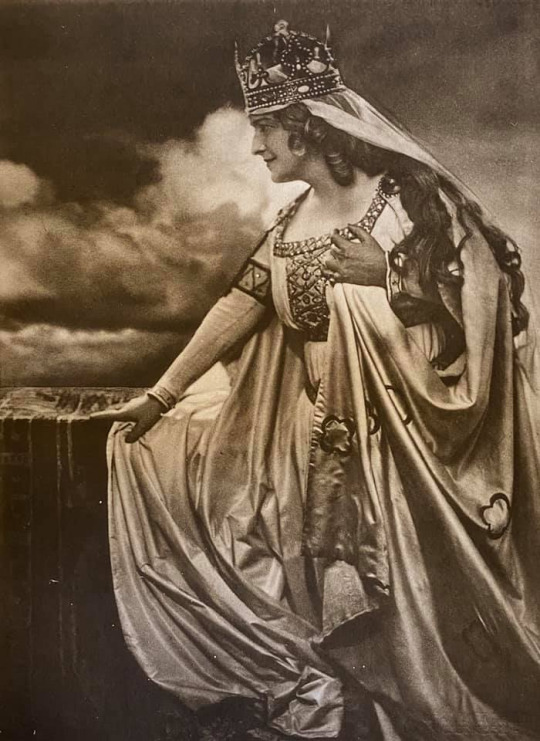
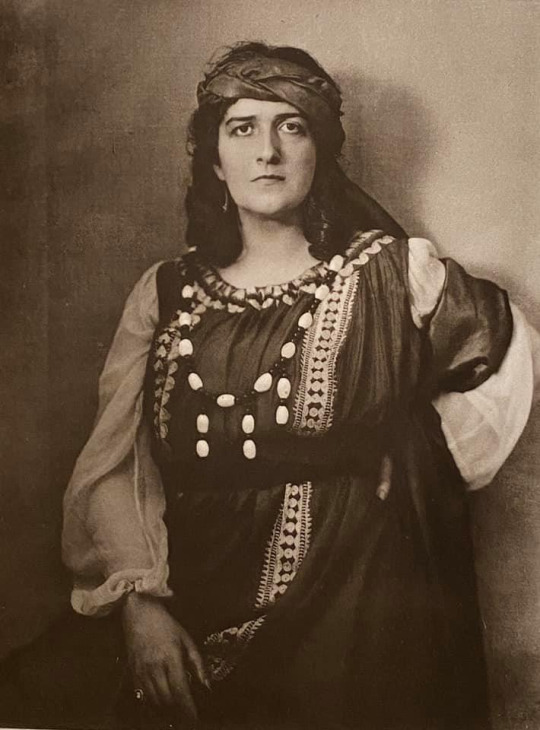
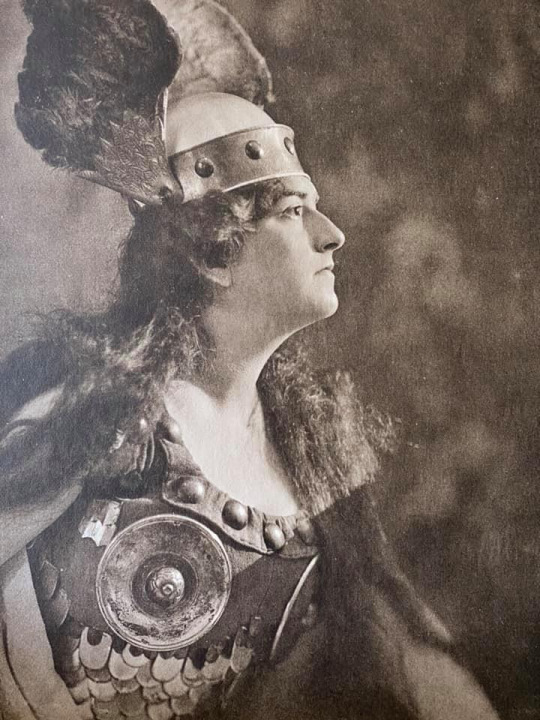
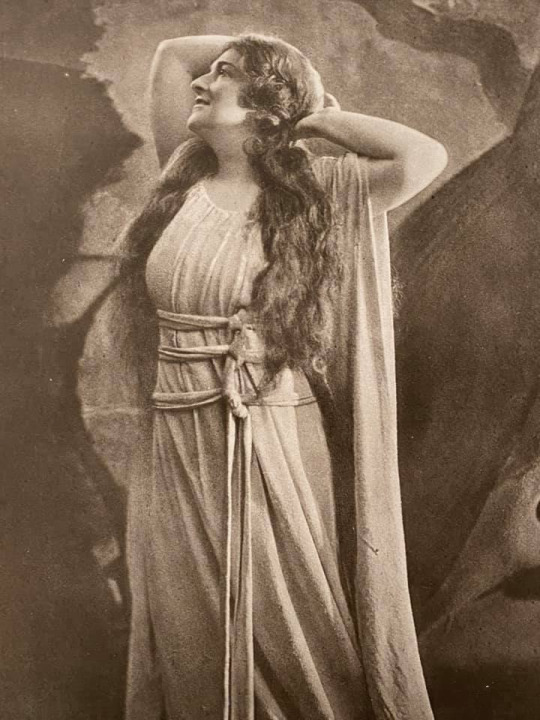
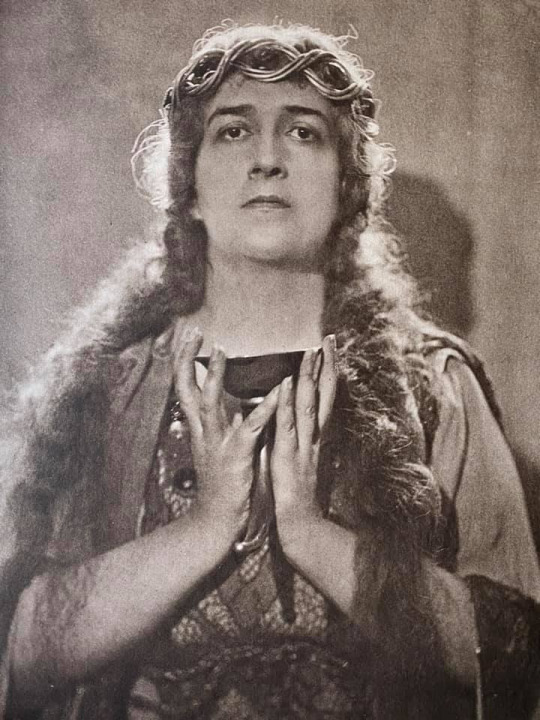
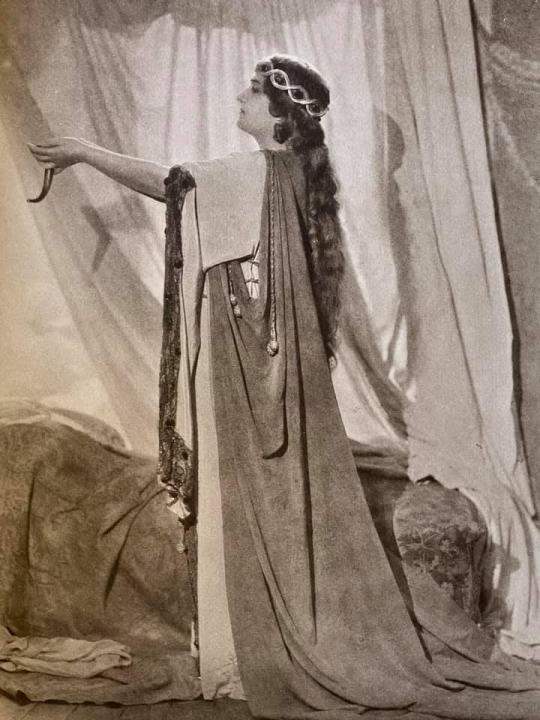
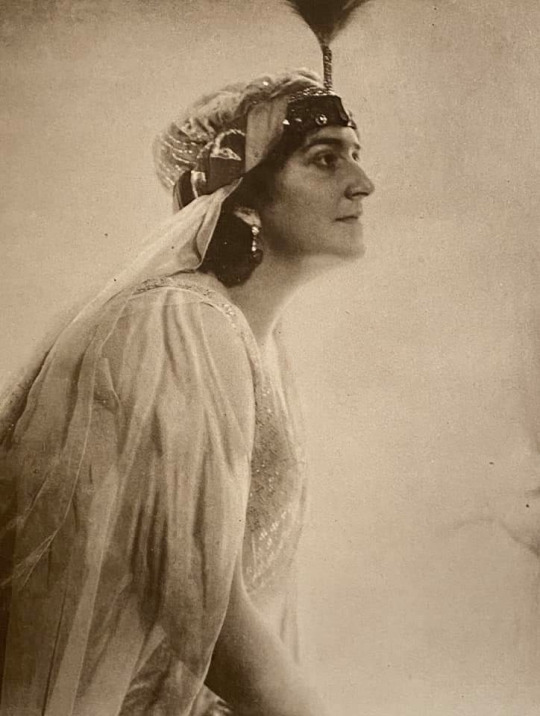
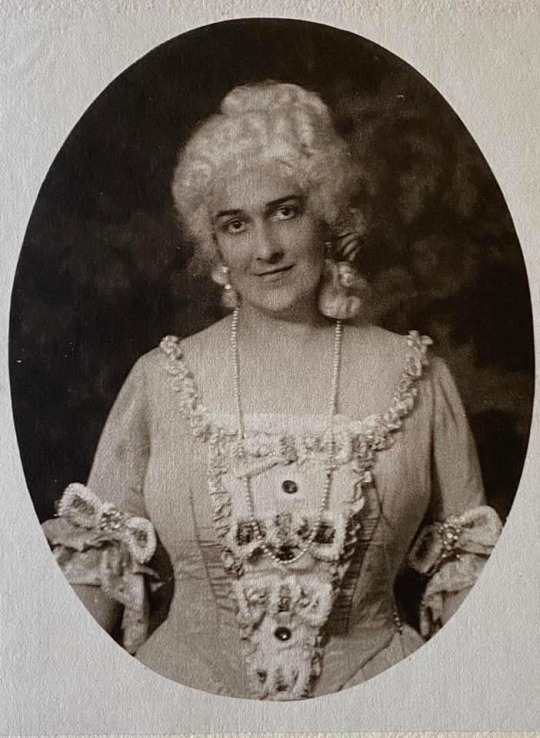
Berta Morena was born Berta Meyer in 1878, at Mannheim. After completing her studies with Mrs Röhr-Brajnin, Regina de Sales and Aglaja von Orgeni she made her debut in 1898 at the Münchner Hofoper as Agathe in Freischütz. The debut was successful and the critics were full of praise for her beautiful voice as well as for her beauty. During the next seasons she appeared in a variety of roles, gradually gaining a reputation, especially in Wagnerian roles. From 1903 she sang Brünnhilde, from 1907 she was very successful as Leonore in Fidelio. Within a short time, she became Munich’s most beloved singer, appearing there as Elisabeth, Elsa, Eva, Isolde, Kundry, Sieglinde, the Brünnhildes, Senta, Santuzza, the title role in Lachner’s Catharina Cornaro, Kassandra in Weingartner’s Orestes, Giulietta in Les Contes d’Hoffmann, Aida and in Charpentier’s Louise. One of her best roles was Rachel in Halévy’s La Juive. In 1908 she was invited to sing at the Metropolitan, where she appeared in 56 performances during four seasons singing Leonore in Fidelio under Gustav Mahler, but she could not erase still vivid recollections of Lilli Lehmann and Amalie Materna in the role. Elisabeth and Sieglinde were considered the best performances during her Met career. Berta Morena sang widely as a guest artist, in Vienna, Hamburg, Frankfurt, Hannover, Karlsruhe, Berlin (Hofoper), Zurich, Barcelona, Budapest National Opera and London (1914). At Covent Garden, she did not please neither as Isolde nor as Kundry, but her Sieglinde was exceptional. In 1923 she celebrated her twenty-fifth anniversary of membership at the Munich Opera. Soon after she left the Munich Opera on account of disagreements with the management reappearing as Brünnhilde at the Metropolitan. It was not until 1927, that she bade farewell to her audience to become a sought-after singing tutor. Berta Morena died in 1952, at Rottach-Egern (Bavaria). Bertha Morena was one of the most celebrated artists in Munich for 25 years, not only because of her vocal quality as a ‘Hochdramatische’ but also because of her splendid appearance which induced no less an artist than Franz von Lenbach to paint her portrait. When listening to her records you will hear a dark-timbred soprano voice, occasionally having some difficulties with the heights, but she is definitely not a mezzo-soprano as the critic Alfred von Mensi-Klarbach stated at the beginnin of her career. Hers is a warm, bright voice with a quick vibrato, in my opinion ideally suited to the lyric-dramatic repertory.
#Berta Morena#Metropolitan Opera#Covent Garden#Richard Wagner#Carl Maria von Weber#Parsifal#Tristan und Isolde#Lohengrin#Pietro Mascagni#Cavalleria rusticana#Tannhäuser#Ludwig van Beethoven#Fidelio#Die Walküre#Gustav Mahler#Royal Opera House#Der Freischütz#Les Contes d'Hoffmann#Jacques Offenbach#Fromental Halévy#La Juive#Aida#Giuseppe Verdi#Le Nozze di Figaro#Wolfgang Amadeus Mozart
3 notes
·
View notes
Text

Alfa Romeo Giulietta Berline TI
#classic car#classic cars#italian cars#italien#italian car#italian#alfa romeo giulietta#alfa romeo#giulietta
8 notes
·
View notes
Text
Dolores Del Rio and the 1957 Cannes Film Festival by Raquel Stecher

Held every year in May, the Cannes Film Festival (Festival de Cannes) is one of the most celebrated and prestigious events in the film industry. The inaugural festival held in 1939 was cut short when Germany invaded Poland. WWII would stall the festival until 1946. In post-war France, the festival was an opportunity to not only celebrate international film but to drive tourism to the French Riviera. It struggled at first and the 1948 and 1950 festivals were canceled due to economic hardship. By the early 1950s however, Cannes had established itself as a landmark event and filmmakers receiving a Palme d’Or, the festival’s prize for films in competition, became an honor.
The jury for the Cannes’ feature film competition awards, which had flip-flopped between the Grand Prix and Palme d’Or, consisted of delegates from around the world. Actors, directors, writers, historians and other cultural elites were tasked with picking the best of the best and being a juror was a highly sought-after position. As an international festival, it was required that at least four jurors represent countries other than France.
In a previous version of this article, it stated that Dolores Del Rio was the first female juror of Cannes for feature films. Even though this claim has been made by numerous online sources, it was actually film critic and curator Iris Barry who presided as the first woman juror in 1946. The British born Barry had been living and working abroad for some time and served as a delegate representing the United States. The jury was responsible for awarding the Grand Prix, which at the time was given to numerous films including MARIA CANDELARIA (’46), director Emilio Fernandez’ film starring Dolores Del Rio.

Del Rio’s film career began in Hollywood during the silent film era and was followed by a successful transition to talkies. As one of the celebrated female Latin Lovers, she starred in films such as WHAT PRICE GLORY (’26), RAMONA (’28) and FLYING DOWN TO RIO (’33). Frustrated by the quality of roles she was offered and after a painful break up with Orson Welles, del Rio took a break from Hollywood after JOURNEY INTO FEAR (’43) and worked primarily in Mexico but also made films in Argentina and Spain. In 1954, she was denied entry into the U.S. because of suspected communist ties. She was allowed entry in 1956 but would only return to Hollywood for two more films before retiring.
By 1957, del Rio was enjoying much success in her native country of Mexico and the Cannes Film Festival organizer took notice. According to del Rio biographer Linda B. Hall, “she was invited not only to indicate French interest in the Mexican movie industry but particularly to honor Dolores herself, who, he averred, was well known in France for her wonderful screen appearances.” Not only was Mexican cinema thriving but del Rio was also a top talent. She accepted the invitation on February 4th, 1957.
As one of 11 jurors, del Rio was tasked to help select the Palme d’Or winners in the feature film category. She was elevated to vice president status and was given her own secretary (in previous years there was only one secretary for the entire jury). Among her fellow jurors were writers, actors, historians, British director Michael Powell and American director George Stevens. The top prize that year went to William Wyler’s FRIENDLY PERSUASION (’56) and del Rio was quoted as saying “one senses the master hand of an experienced director.” Del Rio also championed the Polish film KANAL (’57), directed by Andrzej Wajda and winner of the Jury Special Prize (in a tie with Swedish filmmaker Ingmar Berman’s THE SEVENTH SEAL), and actress Giulietta Masina, winner of the Best Actress award for THE NIGHTS OF CABIRIA (’57). In addition to judging the 31 films in competition, del Rio had social obligations that included meetings with the festival’s president, the mayor of Cannes and a variety of foreign dignitaries.

After serving on the 1957 Cannes Film Festival jury, del Rio became involved in various efforts to promote and supports the arts in their various forms. She was a juror for the Berlin International Film Festival in 1962 and the San Sebastian Film Festival in 1976. She founded the Cultural Festival Cervantino, promoted the Acapulco International Film Review, worked for the Mexican Actors’ Guild and co-founded the Society for the Protection of Artistic Treasures of Mexico.
As of 2019, there have been over 170 women jurors, at least one woman on every jury since del Rio’s stint in 1957. In 1965, actress Olivia de Havilland became the first woman jury president and there have been a total of 12 so far. Others include Sophia Loren, Michele Morgan, Ingrid Bergman and Jeanne Moreau. Nevertheless, Cannes still struggles with gender equity. At the 2018 festival, jury president Cate Blanchett led a group of 82 women in protest. Eighty-two represents the total number of female directed films that had been in competition up until that point. That same year Cannes signed a 50/50 by 2020 Parity Pledge for equal representation.
110 notes
·
View notes
Video
youtube
FRANCO CORELLI SINGS AGAIN PUCCINI TOSCA " E LUCEVAN LE STELLE" LIVE 1955 RARE
In the summer of 1951, Corelli won the Maggio Musicale Fiorentino in Florence, earning a debut at Spoleto the following fall. He was originally scheduled to sing Radames in Verdi's Aïda and spent three months preparing the role with conductor Giuseppe Bertelli. However, Corelli eventually switched to Don José in Bizet's Carmen, feeling that at this point he lacked the technical finesse and legato for the role of Radamès. In November 1951, he made his debut at the Rome Opera as Manrico in Il trovatore opposite Maria Caniglia as Leonora. The next year he appeared in operas with smaller opera houses throughout Italy and on the Italian radio. In 1953 he joined the Rome Opera's roster of principal tenors where he spent much of his time performing through 1958. His first role with the company in 1953 was that of Romeo in Zandonai's rarely heard opera Giulietta e Romeo. Later that season he sang Pollione in Bellini's Norma opposite Maria Callas in the title role. It was the first time the two sang opposite one another and Callas immediately became an admirer of Corelli. The two performed frequently with each other over the next several years in a partnership that lasted to the end of Callas's career. While singing at the Rome Opera, Corelli also made numerous appearances with other opera houses both in Italy and internationally. He made his first appearance at La Scala in Milan in 1954, as Licinio in Spontini's La vestale opposite Callas's Giulia for the opening of the 1954-1955 season. He returned several more times to that house over the next five years, singing opposite Callas in productions of Fedora (1956), Il pirata (1958) and Poliuto (1960).[1] He also notably portrayed the role of Dick Johnson in a highly celebrated performance of La fanciulla del West at La Scala in 1956, opposite Gigliola Frazzoni and Tito Gobbi, which was broadcast live on Italian radio.[1] Other important debuts for Corelli soon followed, including his first appearances at: the Maggio Musicale Fiorentino in Florence and the Arena di Verona Festival in 1955; the Vienna State Opera, as Radamès, and the Royal Opera House, Covent Garden, in London, as Cavaradossi, in 1957;[1] the Teatro Nacional de São Carlos in Lisbon, the Lyric Opera of Chicago and the San Francisco Opera in 1958; and the Berlin State Opera in 1961. Among the many triumphs of the decade for Corelli were two highly celebrated performances at the Teatro di San Carlo in Naples, a 1958 appearance as Don Alvaro in La forza del destino opposite Renata Tebaldi as Leonora and a 1959 performance of Maurizio in Adriana Lecouvreur opposite Magda Olivero in the title role. During his early career, Corelli sang in a number of rare operas in which he triumphed including performances of Spontini's Agnese di Hohenstaufen, Handel's Giulio Cesare and Hercules, Prokofiev's War and Peace, and the world premiere of Guido Guerrini's Enea. By 1960 his active repertory included some 30 roles including the title role in Giordano's Andrea Chénier, Turiddu in Mascagni's Cavalleria rusticana, Rodolfo in Puccini's La bohème, and the title roles in Verdi's Don Carlo and Ernani. In 1957 Corelli met soprano Loretta di Lelio when she came backstage after one of his performances at the Rome Opera House to get his autograph. They began seeing each other romantically and married in 1958. After their marriage, Loretta gave up her fledgling opera career to serve as her husband's business manager, secretary, public relations agent, cook, and English translator. Their marriage ended upon Corelli's death forty-five years later. (Wikipedia)
3 notes
·
View notes
Text
The First Corvettes To Race At Le Mans – The Cunningham 1960 Chevrolet Corvette
In 1960 the Americans would arrive at the world’s most famous endurance race with a bang – three specially prepared 1960 Chevrolet Corvettes rolled off the trucks at the Circuit de la Sarthe to challenge for wins at the 24 Hours of Le Mans for the first time.
The truth of the matter is that the Europeans were almost entirely dominant in both pre and post-WW2 top flight motor racing. The Brits, Italians, Germans, and French knew how to make the fastest cars in the world and the Americans often weren’t taken particularly seriously in races outside their own borders.
The 1960 Le Mans would go a long way towards changing this preconception.
Briggs, Zora, and $11,730.24 Worth of Corvettes
The team behind the development of the Corvette was led by Zora Arkus-Duntov, a fascinating man who had been born to Russian parents when they lived in Belgium, then raised largely in Berlin before fleeing to joint the French Air Force and fight the Nazis when WW2 broke out.
After the fall of France Zora and his family left Europe for the the United States, where they fell in love with the country, staying there for the rest of their lives. Zora had always loved fast vehicles, he started out with motorcycle racing before moving to cars, he proved both a highly capable engineer and a world class racing driver – achieving class victories in 1954 and 1955 24 Hours of Le Mans driving for Porsche.
In 1953 Zora had started working at GM and by 1955 he was the director of high performance at Chevrolet, he led the engineering of the Corvette, turning it from a 6-cylinder light sports car into a V8-powered racer that would take on the best in the world – and win.
After the 1955 Le Mans Disaster many manufacturers had left motor racing to the privateers, Chevrolet was one of them, much to Arkus-Duntov’s chagrin – he wanted to test the mettle of the Corvette against Europe’s best.
In the late 1950s Arkus-Duntov convinced Briggs Cunningham to take three Corvettes to Le Mans as a privateer – Cunningham was born into staggering wealth but he’d always shown much more interest in racing than money management, particularly yacht and automobile racing. By the late 1950s he’d already won the America’s Cup yacht race, the most prestigious in the world, and Arkus-Duntov talked him into entering three competition-prepared Corvettes at Le Mans.
Cunningham was no newcomer to Le Mans, he’s had developed and raced his own prototype sports cars at the event, taking a class win in 1953 with the Cunningham C5-R. His team had raced modified American road cars and prototypes extensively at Le Mans since 1950, becoming fan favourites in the process.
Entering the 1960 Le Mans
The Cunningham team bought three 1960 Corvettes from Don Allen Chevrolet, each was optioned to the gills with every performance tweak available including a 290 hp fuel-injected V8, quick-ratio steering, heavy-duty sintered-metallic brake linings, heavy-duty suspension, a close-ratio four-speed transmission, a Positraction limited-slip differential, a radio delete, and a temperature-controlled radiator fan.
Before shipping the cars to Europe they fitted a series of their own upgrades including Stewart Warner gauges, a Halibrand quick release fuel cap, Halibrand knock off wheels with Firestone racing tires, Koni competition shock absorbers, Bendix fuel pumps (a primary and a back-up), an additional front additional sway bar, a 37 gallon fuel tank, brake ducting from the grille area and a cooling duct from drivers side front bumper area (directing cooling air to the driver through the foot well), two seats from a Douglas C-47 Skytrain aircraft, and Sebring exhausts that exit in front of the rear tires.
The Corvettes would face stiff competition in Europe, they’d be racing against the Ferrari 250 TR59, the Aston Martin DBR1, the Porsche 718, the Ferrari 250 GT SWB, the Porsche 356B Carrera, the Triumph TRS, the Maserati Tipo 61, the Jaguar E2A, the Alfa Romeo Giulietta SV Spyder, and a number of others.
The race took place over the 25th and 26th of June, Ferrari needed an outright win at Le Mans to take the FIA World Sports Car Championship title, so they brought 8 of their best cars. The race was always going to be a challenge but during the third hour a storm swept across the track bringing torrential rain which caused a number of accidents, shaking up the running order.
The rain continued intermittently throughout the night but began to clear by the morning, sadly two of the three Corvettes had been falling by the wayside, one of the cars had been rolled and was out of the race and another got stuck in the sand by the truck – losing valuable time before being recovered and getting back into the race (this was the car shown here).
By the time the chequered flag fell one of the Corvettes was still running – it took a class win at Le Mans and finished 8th overall. This was a great result for the first Corvette outing at the famous event, and although they didn’t know it at the time it was just the first of many, Corvettes have been racing at Le Mans for decades since.
youtube
The 1960 Chevrolet Corvette Shown Here
The car you see here is one of the three original 1960 Le Mans Corvettes, it’s been restored back to its original 1960 livery and specifications, and it won the Preservation Award at the 2016 San Marino Motoring Classic, as well as the Corvette class at the 2008 Pebble Beach Concours d’Elegance.
The car is now in the care of Bruce Meyer, a well known classic car enthusiast who specialises in historically significant automobiles. If you’d like to see it in person the good news is that you can – the car is one of the main exhibits at the Petersen Automotive Museum’s new exhibit dedicated to the cars owned by Meyer.
If you’d like to see more or get your tickets you can click here to visit the website.
The post The First Corvettes To Race At Le Mans – The Cunningham 1960 Chevrolet Corvette appeared first on Silodrome.
source https://silodrome.com/1960-chevrolet-corvette/
54 notes
·
View notes
Text
May 23
On May 23, 1950, Maria Callas made her Mexican debut in “Norma” at the Palacio de los Bellas Artes, Mexico City. Giulietta Simionato was Adalgisa and Kurt Baum was Pollione. The performance was recorded; John Ardoin is scathing about the conducting (by Guido Picco) but cites this recording as one example among her early recordings that trace her “growth as an artist”

On May 23, 1954, Callas sang the first of two performances of “La forza del destino” at the Teatro Communale Alighieri in Ravenna. Mario del Monaco sang the tenor role. Her only other staging of the role was in Trieste in 1948 (four performances). I suspect she accepted this engagement to help her prepare for the EMI recording that was made in August, 1954. The theatre was designed by the same architects who designed La Fenice in Venice.

On May 23, 1963, Callas sang arias in concert (Prêtre conducting) in Stuttgart’s Liederhalle. A recording was made of this plus the earlier Berlin concert. Just as the Mexico City “Norma” helps document her vocal rise, this helps document her vocal decline. Ardoin: “she performs a minimal amount of music and…a good deal of vigor is lacking….”

0 notes
Photo


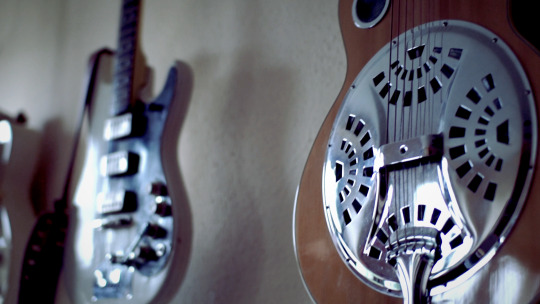





From November 2016 until July 2017, Aaron Levin Harder recorded all of his studio recordings at his home in Prenzlauer Berg, Berlin. Being in the center of Berlin, he regularly went out to play on the streets and was known in the neighborhood for his unique appearance, often playing his steel resonator guitar and being dressed in his Hip-Hop style clothing. He also performed live in a handful of bars around the area, one being the venue where he recorded his Another Night Alone concert show.
Seen here are pictures from his home studio that are showing his equipment and guitars, as well as shots from the neighborhood-scenery.
Recording dates of tracks released as part of The Aaron Levin Harder Legacy that have been recorded by Harder at his home studio:
03.11.16
► The Blues -Demo Recordings | Demo album
04.11.16
► Giulietta (Alternate Studio Demo) | Demo track
14.11.16
► Have You Ever Loved A Woman (Alternate Take) | Single track
31.12.16
► New Years Blues (One More Year To Suffer) | Single track
09.05.17
► Blues Done Let Me Dyin | EP
10.05.17
► I Would Die 4 U (Instrumental tracking) | Guitar tracks
► Whatever (Mad Medley Instrumental) | Single track
13.05.17
► I Would Die 4 U (Instrumental Mix) | Mixing
16.05.17
► It’s A Lonesome World | Single track
► Wonderful Girl | Single track
31.05.17
► Be My Parachute (Take 1) | Single track
► Free Fall (Take 1 & 2) | Single track
05.06.17
► Forgive My Lonely Soul (Take 1-6) | Single track recording session
07.06.17
► Forgive My Lonely Soul (Take 7) | Single track
► Free Fall (Take 3) | Single track
08.06.17
► Mad Medley (Short Alternate Version) | Single track
07.06.17
► Be My Parachute (Take 2) | Single track
► Money Don’t Matter Tonight (Take 1 & 2) | Single track recording session
18.06.17
► Into You | Single track
18.07.17
► Smokestack Lightning (Alternate Version) | Single track
► Your Love (Is So Hard To Take – Take 1 & 2) | Single track recording session
0 notes
Photo

🚘 #bixentef #tourisme #automobile #meteocar #vintage #legendcar #italycar 🇮🇹 #france 🇫🇷 #alfaromeogiuliettaSprint 1960 : Commercialisation du coupé Alfa Romeo Giulietta SZ (Sport Zagato) dessinée par le carrossier Zagato à la carrosserie légère. 1962 : Lancement de la berline Alfa Romeo Giulia. Les Giulietta Sprint et Spider changent de nom et leur ligne est modernisée. Elles adoptent la mécanique 1,6 litre de 92 ch, BV5 des Giulia. 1963 : Lancement du coupé Alfa Romeo Giulia Sprint GT coupé signé Bertone, la Giulietta SS devient Giulia SS avec 112 ch et 195 km/h. 1964 : Pour le marché italien, introduction de l'Alfa Romeo Giulia Sprint 1300 avec freins à disques AV de série. 1965 : Arrêt des Alfa Romeo Giulietta Sprint et des Alfa Romeo Giulietta berline TI. Les Alfa Romeo Giulietta, comme leur remplaçante Giulia, sont des automobiles qui sont la quintessence d'une belle mécanique et d'un style classique purement italiens. Elles sont conçues autour d'un moteur d'abord de 1,3 puis 1,6 litre avec bloc, culasse et carter en aluminium à double arbre à cames en tête et chambres de combustion hémisphériques tournant jusqu'à 7 000 tr/min. La série Giulietta berline et Coupé Sprint sera produite de 1954 à 1962. Elle a ensuite été remplacée par la très moderne et carrée (mais aérodynamique) Alfa Romeo Giulia. La Giulietta SZ (Sprint Zagato) avec un moteur porté à 100 chevaux, raccourcie et allégée à 750 kg, pouvait atteindre les 215 km/h. Les voitures de la seconde série furent les premières au monde à avoir une boîte à 5 rapports de série. L'Alfa Romeo Giulietta Sprint est "désirable" à plus d'un titre. Elle représente l'archétype de la voiture de sport italienne des années 1950 avec un design très réussi et un moteur de feu. Aujourd'hui, du fait de sa rareté et de son histoire, elle est devenue un jalon essentiel des coupés milanais que tout amateur éclairé et averti se doit de posséder dans sa collection personnelle. Ce coupé Giulietta Sprint est actuellement admis dans toutes les manifestations et peut même participer à certaines épreuves de régularité ou de courses anciennes. @wikipedia (à Nîmes) https://www.instagram.com/p/CAJOIonjaJt/?igshid=1mvzccfkkq5vi
0 notes
Text
20-January 散財記録
02(thu) ・Ben LaMar Gay / Downtown Castles Can Never Block the Sun (2018, used CD) 11(sat) ・Boy / Mutual Friends (2011, used CD) ・The Roots / Phrenology (2002, used CD) ・The Sea and Cake / Oui (2000, used CD) ・The King of Luxembourg / "Sir" / Royal Bastard (1989, used CD) 12(sun) ・And Summer Club / HEAVY HAWAII PUNK (2016, used CD) ・The Holy Barbarians / Beat.itude (1995, used CD) ・Luna / Penthouse (1995, used CD) ・New Violin Summit / Live at the Berlin Jazz Festival (1971, used CD-R) 15(wed) ・tiny pop - here's that tiny days (2020, CD) 19(sun) ・Fred Frith Maybe Monday / Digital Wildlife (2002, used CD) ・Stephen Prina / Push Comes to Love (1999, used CD) ・The (International) Noise Conspiracy / The First Conspiracy (1999, used CD) 24(fri) ・El Fog / Rebuilding Vibes (2009, used CD) ・The Black Heart Procession / 2 (1999, used CD) ・Pacific 231 / Miyashiro (1998, used CD) ・Deep Forest / Comparsa (1997, used CD) ・U.G. Man / Classics (1995, used CD) 30(thu) ・GEZAN / 狂(KLUE) (2020, CD) ・包帯人間 / 4+5+1 (2017, used cassette) 31(fri) ・Aurelien Merle / Remerle (2015, CD) ・菅井協太 / y533 (2016, CD) ・quaeru / PLATE (2016, 2CD) ・BOMBORI / PRAYGROUND (2015, CD) ・Giulietta Machine / Machina Nostalgia (2012, CD) ・Loosers / Big Dig (2007, CD) ・The Superimposers / The Superimposers (2005, CD) ・Spam Allstars / ¡Fuacata! Live (2002, CD) ・Fred Locks / Black Star Liner (1995, CD) ・中西俊夫 / HOMEWORK (1983, CD)
0 notes